Protector1: Difference between revisions
Pbcjohnston (talk | contribs) Added photos and captions |
Pbcjohnston (talk | contribs) Moved photo |
||
| Line 9: | Line 9: | ||
[[File:Protector construction 2.jpg|left|500px]] | [[File:Protector construction 2.jpg|left|500px]] | ||
This photo was taken on February 20, 1902 and shows a progression in construction of Protector. You can see the framework for the superstructure being assembled. Two of the superstructure plates are in place. Notice the reverse bow that was becoming a signature of ship design in the last decade of the 19th century and early 20th century. Lake placed his 10 foot long and 14 inch wide hydroplanes | This photo was taken on February 20, 1902 and shows a progression in construction of Protector. You can see the framework for the superstructure being assembled. Two of the superstructure plates are in place. Notice the reverse bow that was becoming a signature of ship design in the last decade of the 19th century and early 20th century. Lake placed his 10 foot long and 14 inch wide hydroplanes alongside this superstructure. One set was just forward of midships and one set just aft of midships. These enabled Lake's well-publicized zero-angle diving method, which he felt was safer than the angled dive of the Electric Boat submarines. The first section of the conning tower has been put in place atop the boat. | ||
<small>Photo in the private collection of Ric Hedman.</small> | <small>Photo in the private collection of Ric Hedman.</small> | ||
[[File:Red bar sub new.jpg]] | |||
[[File:Protectr.jpg|left|500px]] | |||
Lake's Protector of 1901 in the water. This photo was most likely taken shortly after her completion in late 1902. The location is unknown, but is somewhere in the New England area. A significant advance over Argonaut I and II, Protector had more powerful engines and motor, and three torpedo tubes. It also had Lake's standard wheels for rolling on the bottom and a diver's lockout chamber. Protector was the first Lake boat that incorporated his zero-angle diving method (also called "even keel diving") using amidships diving planes. Note guards at side of vessel to protect the diving planes from damage. There is a helm wheel in place on top of the conning tower. The "armored sighting hood" just aft of the helm wheel does not yet have the gun installed in it (see below). | |||
Lake tried to sell this boat to the Navy, but it was rejected because the Navy had already committed funds to buy the Holland/Electric Boat designed [[A-class|'''A-class''']]. Unable to arouse interest in this boat in the U.S. and desperately needing the cash influx, Lake sold the boat to Russia, who renamed it Osetr. Five additional copies were built in Russia. | |||
<small>National Archives photo.</small> | |||
[[File:Red bar sub new.jpg]] | [[File:Red bar sub new.jpg]] | ||
[[File:Protector running awash.jpg|left|500px]] | [[File:Protector running awash.jpg|left|500px]] | ||
Simon Lake at the conn of the Protector, likely somewhere in Long Island Sound, 1903. He is deliberately running the boat partly submerged with a hatch open to demonstrate the controllability of the boat. This is an extraordinarily dangerous thing to do as one moment of inattention | Simon Lake at the conn of the Protector, likely somewhere in Long Island Sound, 1903. He is deliberately running the boat partly submerged with a hatch open to demonstrate the controllability of the boat. This is an extraordinarily dangerous thing to do as one moment of inattention could cause the boat to go under, swamping the hatch and flooding the boat. On the left is the "armored sighting hood" with a rapid fire gun installed, likely a Hotchkiss Mk 1 1-pdr 20 caliber weapon. This is the first gun installed on an American submarine. Just behind this and forward of the hatch is Lake's patented omniscope, his version of a periscope. Trailing behind the boat is the gasoline engine exhaust tube. This gave the Protector the theoretical ability to run the engine while cruising awash like this, as long as the hatch was open to pull in air for the engine. However, it is likely that the boat in running on the battery in this photo. | ||
<small>A public domain photo in the private collection of Ric Hedman.</small> | <small>A public domain photo in the private collection of Ric Hedman.</small> | ||
Revision as of 19:52, 30 June 2024
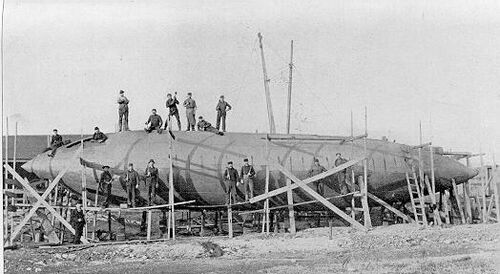
Photo in the private collection of Ric Hedman.
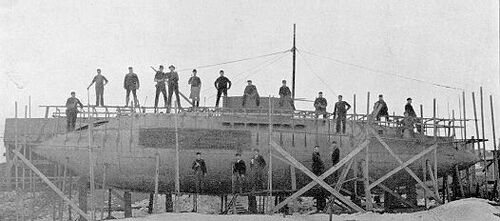
This photo was taken on February 20, 1902 and shows a progression in construction of Protector. You can see the framework for the superstructure being assembled. Two of the superstructure plates are in place. Notice the reverse bow that was becoming a signature of ship design in the last decade of the 19th century and early 20th century. Lake placed his 10 foot long and 14 inch wide hydroplanes alongside this superstructure. One set was just forward of midships and one set just aft of midships. These enabled Lake's well-publicized zero-angle diving method, which he felt was safer than the angled dive of the Electric Boat submarines. The first section of the conning tower has been put in place atop the boat.
Photo in the private collection of Ric Hedman.
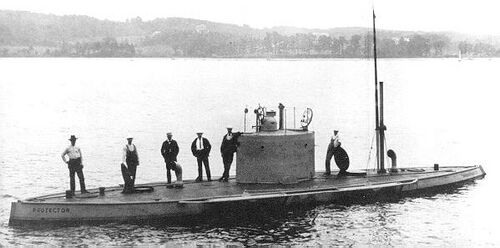
Lake's Protector of 1901 in the water. This photo was most likely taken shortly after her completion in late 1902. The location is unknown, but is somewhere in the New England area. A significant advance over Argonaut I and II, Protector had more powerful engines and motor, and three torpedo tubes. It also had Lake's standard wheels for rolling on the bottom and a diver's lockout chamber. Protector was the first Lake boat that incorporated his zero-angle diving method (also called "even keel diving") using amidships diving planes. Note guards at side of vessel to protect the diving planes from damage. There is a helm wheel in place on top of the conning tower. The "armored sighting hood" just aft of the helm wheel does not yet have the gun installed in it (see below).
Lake tried to sell this boat to the Navy, but it was rejected because the Navy had already committed funds to buy the Holland/Electric Boat designed A-class. Unable to arouse interest in this boat in the U.S. and desperately needing the cash influx, Lake sold the boat to Russia, who renamed it Osetr. Five additional copies were built in Russia.
National Archives photo.
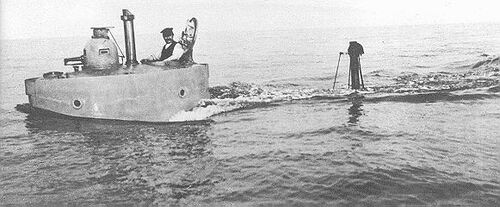
Simon Lake at the conn of the Protector, likely somewhere in Long Island Sound, 1903. He is deliberately running the boat partly submerged with a hatch open to demonstrate the controllability of the boat. This is an extraordinarily dangerous thing to do as one moment of inattention could cause the boat to go under, swamping the hatch and flooding the boat. On the left is the "armored sighting hood" with a rapid fire gun installed, likely a Hotchkiss Mk 1 1-pdr 20 caliber weapon. This is the first gun installed on an American submarine. Just behind this and forward of the hatch is Lake's patented omniscope, his version of a periscope. Trailing behind the boat is the gasoline engine exhaust tube. This gave the Protector the theoretical ability to run the engine while cruising awash like this, as long as the hatch was open to pull in air for the engine. However, it is likely that the boat in running on the battery in this photo.
A public domain photo in the private collection of Ric Hedman.
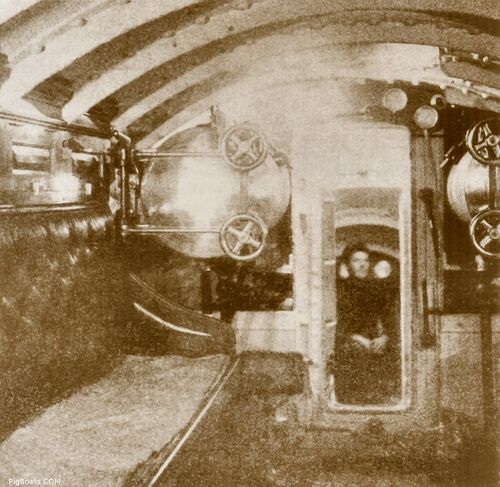
A January, 1904 photo of the Protector's interior. This view is looking forward towards the bow. It can be seen that the torpedo tube inner doors are actually in the compartment with the bench seats. Spare torpedoes are being kept under the bench seats, although that would limit the number of torpedoes that could be carried. The watertight door leads into the diving compartment, and a crewman can be seen sitting in there.
Library of Congress photo.

This view inside Protector is looking aft from the area of the torpedo tube breech doors. It is quite possible that the man lying on the settee sleeping is Simon Lake. He appears to be older and has a mustache. This posed photo was meant to emphasize the level of "comfort" that Lake had built into boat. It has the look of a Pullman railroad car. The view is looking aft and through the pantry where food could be prepared into the engine room, where two men are looking at the camera. The area could be closed off from the forward compartment by two swinging doors with glass windows. These are non-watertight doors and were mostly intended for isolation of noise and fumes from the engine room.
Library of Congress photo.
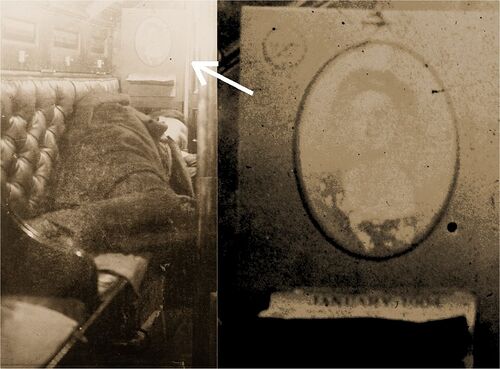
This is a closeup of the photo above and shows a calendar hanging on the bulkhead that gives the date. In February 1904 the Protector was sold to the Russian Navy at the outbreak of the Russo-Japanese War. The calendar above his head firmly dates this photo to January or early February 1904 before the Protector was sold to Imperial Russia as the "Osetr". Lake spent the next seven years in Europe designing submarines for the Austro-Hungarian Navy, the Kaiserliche Marine, and Imperial Russian Navy.
Library of Congress photo.
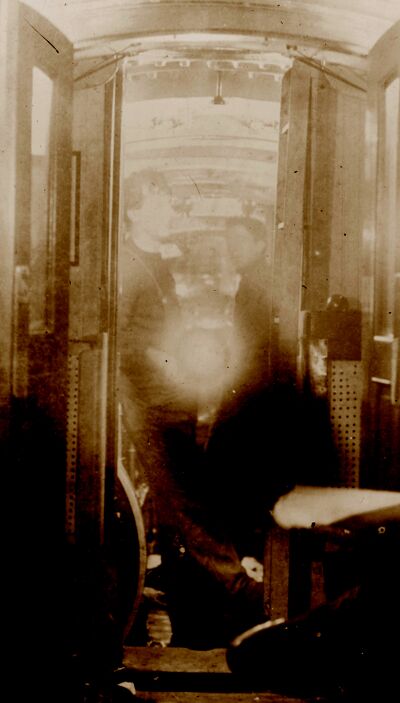
Another closeup of the aft looking photo above, showing details of the pantry and engine room. Just visible on the right aft of the small pantry is a ladder leading up to the conning tower (see diagram below).
Library of Congress photo.
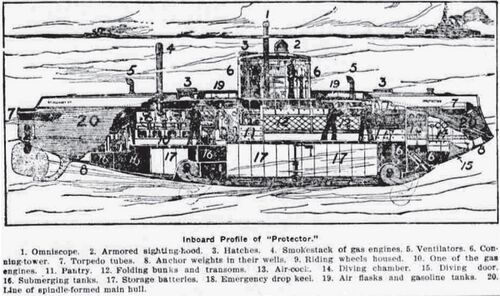
This contemporary drawing of Protector gives a good view of the boat's interior arrangement. There was no traditional control room that had become the standard on the Electric Boat units. Instead, all control functions were centered in the conning tower, which was made of brass. The conning tower also had a viewing station for the boat's "omniscope", Simon Lake's design for a primitive periscope. It was a fixed height instrument that did not rotate. Instead, the user could rotate the prism set inside the unit to alter the field of view.
Library of Congress image/The Logan Republican (Logan, Utah)
Page created by:
Ric Hedman & David Johnston
1999 - 2023 - PigBoats.COM©
Mountlake Terrace, WA, Norfolk, VA
webmaster at pigboats dot com
